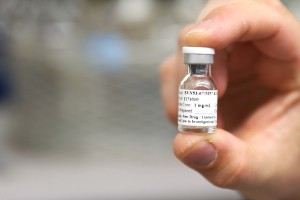
Results of a study led by researchers at Roswell Park Comprehensive Cancer Center are shedding light on why some newly diagnosed glioblastoma patients survive longer than others after receiving standard treatment in conjunction with the therapeutic brain cancer immunotherapy SurVaxM.
The team’s findings, newly reported in the journal Cancer Immunology & Immunotherapy, linked long-term survival to the tumour’s molecular characteristics prior to treatment.
Glioblastoma is the most common, aggressive and deadly type of brain tumour, with fewer than 7% of patients surviving five years after diagnosis.
“There is an urgent need for more effective treatments for glioblastoma, which claims about 10,000 lives in the U.S. every year,” says Michael Ciesielski, PhD, Assistant Professor of Neurosurgery and Director of the Neuro-Oncology Lab at Roswell Park. He and Robert Fenstermaker, MD, Professor of Neurosurgery and Oncology and Chair Emeritus of the Department of Neurosurgery, co-developed SurVaxM and are co-senior authors of the study.
SurVaxM, developed at Roswell Park, targets the deadliest type of brain cancer.
The findings are based on the results of a single-arm phase 2 clinical trial in which 63 patients underwent surgery and chemoradiation and received the chemotherapy temozolomide followed by a series of SurVaxM injections.
Investigators used whole-exome and RNA sequencing to identify genetic variations and levels of gene activity in the pre-treated tumours of 34 of those patients.
They then compared the tumour profiles of patients who had short-term overall survival (fewer than 18 months) versus long-term overall survival (more than 18 months).
They found that the tumours of long-term survivors contained especially high proportions of B cells and T cells — part of the immune system’s cancer-killing arsenal — and enriched gene sets for interferon-gamma (IFN-γ) and interferon-alpha (IFN-α), which help the immune system launch a stronger attack against the tumour.
The authors noted that a five-gene expression signature and B-cell-specific signature predicted length of survival in the patients who received SurVaxM, but the same tumour characteristics were not associated with improved survival in a group of patients who underwent similar treatment but did not receive immunotherapy.
“Our findings suggest that analysing patients’ tumours before treatment could help us identify those who would be most likely to benefit from SurVaxM or other types of immunotherapies,” says Dr. Ciesielski.
SurVaxM targets survivin, a protein found in 95% of glioblastomas that is essential to their survival. Evidence to date suggests that the immunotherapy helps prevent recurrence by stimulating the patient’s own immune system to find and destroy cells containing survivin. Ten patients have survived seven years or longer after receiving SurVaxM, including five patients whose disease has not recurred.
Because survivin is also present in many other cancers, SurVaxM is also being evaluated in clinical trials for adult patients with neuroendocrine tumours and multiple myeloma, and in paediatric patients with specific brain tumours.
Henry Withers, PhD, of the Biostatistics and Bioinformatics Department at Roswell Park is first author of the paper.
The team included researchers from the Miami Cancer Institute, Dana-Farber Cancer Institute, Massachusetts General Hospital Cancer Center, Beth Israel Deaconess Medical Center, Rose Ella Burkhardt Brain Tumor Center, Cleveland Clinic Neurological Institute and Brown University Health Cancer Institute.
Source and image: Roswell Park Comprehensive Cancer Center
We are an independent charity and are not backed by a large company or society. We raise every penny ourselves to improve the standards of cancer care through education. You can help us continue our work to address inequalities in cancer care by making a donation.
Any donation, however small, contributes directly towards the costs of creating and sharing free oncology education.
Together we can get better outcomes for patients by tackling global inequalities in access to the results of cancer research.
Thank you for your support.